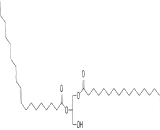diacylglycerol (DAG) is a glyceride consisting of two fatty acid chains covalently bonded to a glycerol molecule through ester linkages. One example, shown on the right, is 1-palmitoyl-2-oleoyl-glycerol, which contains side-chains derived from palmitic acid and oleic acid. Diacylglycerols can also have many different combinations of fatty acids attached at both the C-1 and C-2 positions. In biochemical signaling, diacylglycerol functions as a second messenger signaling lipid, and is a product of the hydrolysis of the phospholipid PIP2 (phosphatidyl inositol-bisphosphate) by the enzyme phospholipase C (PLC) that, through the same reaction, produces inositol triphosphate (IP3). Although inositol triphosphate (IP3) diffuses into the cytosol, diacylglycerol (DAG) remains within the plasma membrane, due to its hydrophobic properties.

